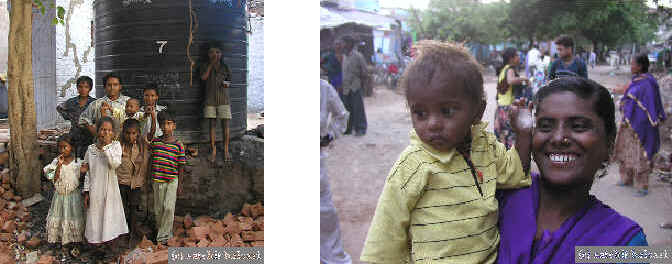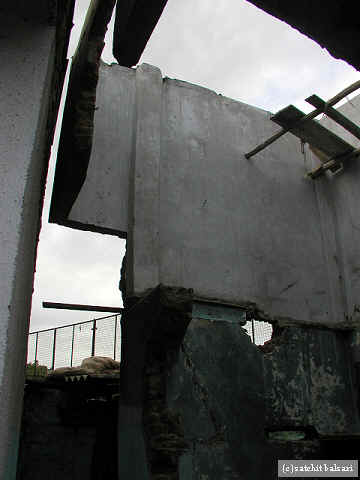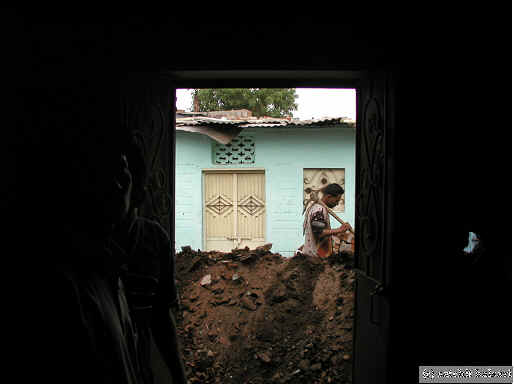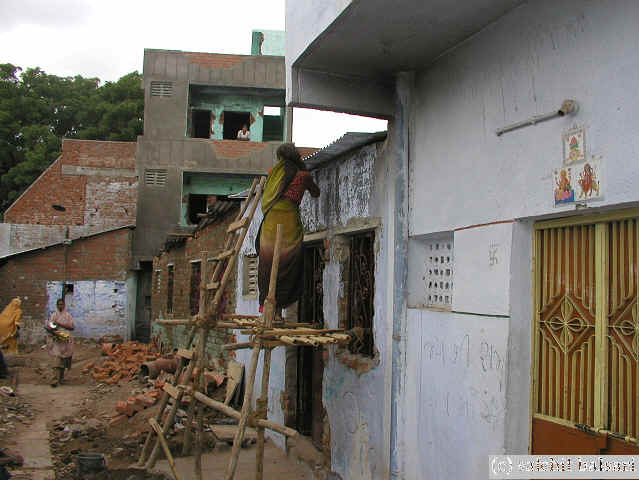
Choksi ni Chaal

(The road to Choksi ni chawl)
The roads to localities that were plundered during the carnage, are lined by memories: debris that once constituted homes that housed happy hard working families. In the rubble, as Hazrat(*) -- holding her infant child -- points out, are not just bricks. In the rubble lie smashed furniture, radios, televisions, refrigerators, books, kitchen mixers, racks and phones, the acquisition of each of which is always a milestone in the lives of millions of hardworking Indian families. In each foot of rubble as Joweherbhai(1) points out, is a scorched refrigerator that (bought after years of hard labor) quenched the family's and its neighbour's thirst in the long hot summer days of Gujarat, or a television at whose foot was crammed the whole mohalla watching the cricket match cheering Sachin(2), or a Bajaj two-wheeler on whose pillion sat the children for a weekly joyride.
While acknowledging what has happened is most unfortunate, many suggest looking at the future, urging to keep a focus on rebuilding both homes and lives. But the tools to rebuild have also been denied: by the events of the past and the occurrences of the present. By the past, for the means of livelihoods that these families had, have also been buried in the rubble: sewing machines, hand carts, books, ledgers, tools, taxis and rickshaws. And the present, for rehabilitation efforts are being hampered by the state machinery.

(Burnt rickshaw peering out from the rubble swept to the side of the road)
Hazrat takes us around Choksi ni Chawl. We enter through a narrow alley, between homes that used to host a busy community where passersby jostled with each other in everyday hurry. At its mouth we were met with a babbling bunch of children, by now used to strangers asking them stranger questions.

(L)Children at Choksi ni chawl in front of a donated water tank. Local authorities have still not supplied a water connection. (R)Hazrat and her infant, making the best of their lives.
 (Alley in Choksi ni
chawl littered with the remains of the homes it connected. Salim Mia (*), a
lawyer,(r-in the pic.) begged us to send him copies of the law books lost in the
fire)
(Alley in Choksi ni
chawl littered with the remains of the homes it connected. Salim Mia (*), a
lawyer,(r-in the pic.) begged us to send him copies of the law books lost in the
fire)
Hazrat leaves us to go back to the relief camp and prepare meals for the menfolk who labor all day to rebuild their houses. The task that lies ahead is daunting. None of the roofs have survived. Most walls have collapsed, soot still lines the walls. Liquid petroleum gas cylinders burst by the rioting mobs have left gaping holes in the floors. Before the houses were thus destroyed, care was taken to rip out electric and plumbing fixtures ensuring that the survivors (if any, and if they returned) would not have an easy start. Four foot high rubble dots the back entrances. Some houses show signs of new doors and windows, symbols of charity. There are no state employed teams rebuilding the houses. Salim mia informs us that the little reconstruction we see is due to the efforts of the few NGOs working amidst all opposition, in Gujarat.
It has been concluded by many reports (several publications), that the element of spontaneity in the riots was dwarfed by the meticulous premeditation. To imagine several thousand people across the state of Gujarat 'spontaneously reacting' to the events in Godhra in a systematic and uncannily uniform manner would indeed be naive. The definite pattern recorded by several previous reports was confirmed by this investigation. All houses were found stripped bare of all amenities, and many destroyed with the use of LPG cylinders. Inspite of having used gas cylinders and having set entire bastis on fire, there were no reported casualties from the mobs, thus suggesting a previous training in arson. The presence of thousands of swords and trishuls (tridents) remains a dead giveaway to preplanning.

(Note the complete collapse of the floor separating the two levels. This is characteristic of most of the houses surveyed in various parts of Gujarat)

(View from the third level. One can see people on each storey as one peers down the holes left by the bursting gas cylinders)


(Note the complete collapse of the first floor slab and the deliberate & meticulous destruction of electrical outlets )

(Charred ceiling of a house)

(A generous coat of soot on the walls)

(Back door of Salim's house clogged with the rubble of his home)

(Where the menfolk are dead, the women have no choice but to take on added responsibility, including that of construction work...)

(....Irrespective of their age) Mumtaz lost several members of her family. Her daughter-in-law, in her third trimester and suffering from hepatitis, cannot help Mumtaz with rebuilding the house. Neither relief material nor medical care had reached them. Mumtaz was seen digging into the ground to collect earth to rebuild her house - a once solid structure of concrete.
(*-name changed)
(1-M.H.Jowher, Director, Society for Promotion of Rational Thinking)
(2-"We should not get worked up about some elements of our minority communities occasionally identifying with majority communities of other nations. We must understand that every minority basks in the glory of a majority with whom they share cultural, religious or national heritage. This is as true of French Jews basking in the Israeli victory of 1973, as with Indians in England cheering the Indian cricket team. This is also true for a few Muslims in India cheering the victory of the Pakistan cricket team. Let us not get too worked up on this. This is natural and will go away in due course" - Narayan Murthy, Chairman of the Board, Infosys Technologies Ltd. Full article available at. http://www.indian-express.com/full_story.php?content_id=9085